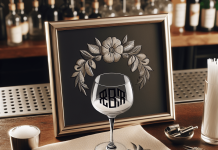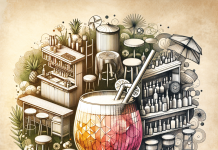Imagine you’re at a swanky cocktail bar, and the bartender confidently starts shaking up your favorite drink. You may wonder – does the way they shake it actually make a difference? As it turns out, the technique used to shake a cocktail can have a profound impact on its taste and texture. From the angle of the shake to the speed and rhythm, every little detail plays a role in the final creation that you hold in your hand. So, next time you order a cocktail, pay attention to the way it’s shaken – it just might enhance your overall drinking experience.
The Importance of Shaking in Cocktail Making
Shaking is a crucial step in cocktail making that goes beyond mere aesthetics. It plays a key role in enhancing flavors, achieving proper dilution, and creating texture and mouthfeel. By understanding the importance of shaking and different shaking techniques, you can take your cocktail game to new heights.
Enhancing Flavors
Shaking cocktails helps to extract delicate flavors and aromas from the ingredients. The vigorous agitation created during shaking allows the different components of the cocktail to blend harmoniously, maximizing the overall flavor profile. Whether it’s citrus juices, herbs, or bitters, shaking ensures that these flavors are evenly distributed and integrated into the drink.
Achieving Proper Dilution
Dilution is another critical aspect of cocktail making, and shaking directly influences this element. When ice is added to the shaker, it begins to melt, releasing water into the mix. This dilution is essential as it helps to soften harsh flavors, balance the overall taste, and create a well-rounded beverage. Shaking plays a vital role in achieving the perfect level of dilution, enhancing the drink’s drinkability and enjoyment.
Creating Texture and Mouthfeel
Shaking not only impacts the taste but also the texture and mouthfeel of a cocktail. The vigorous shaking motion introduces air into the mix, resulting in aeration and foam formation. This added air creates a lighter, smoother, and more velvety mouthfeel. A well-shaken cocktail has a pleasant texture that enhances the overall drinking experience.
Different Shaking Techniques
While the classic shaking method is commonly used, there are several other shaking techniques that can elevate your cocktail-making skills. Familiarizing yourself with these techniques allows you to customize your shaking style based on the desired outcome of your drink.
Classic Shaking Method
The classic shaking method involves using a standard cocktail shaker or Boston shaker. Fill the shaker halfway with ice, add the ingredients, and firmly seal the shaker. Shake vigorously for about 10-15 seconds to ensure proper blending, dilution, and chilling. Strain the cocktail into the desired glassware, leaving any ice shards behind.
Hard Shake
The hard shake is a more vigorous version of the classic shaking method. It requires a firm grip on the shaker and an intense shaking motion. This technique is particularly useful for cocktails with ingredients that require thorough blending, such as heavy syrups or thick fruit juices. The hard shake extracts maximum flavor and creates a smooth, velvety texture.
Japanese Hard Shake
The Japanese hard shake takes the concept of the hard shake to the next level. Developed in Japan, this technique involves incorporating intricate hand movements and a unique grip on the shaker. The Japanese hard shake is renowned for its exceptional aeration and foam creation, resulting in incredibly silky cocktails.
Reverse Dry Shake
The reverse dry shake is a technique commonly used for cocktails that contain egg whites. In this method, rather than shaking first, you begin by first dry shaking the ingredients without ice. The purpose of this step is to emulsify the egg white, creating a rich, frothy texture. After dry shaking, add ice, shake again to chill and dilute the cocktail, and strain into the serving glass.
Throwing/Shaking by Hand
Throwing or shaking by hand is a traditional approach to cocktail shaking, without the use of a shaker. This technique involves vigorously mixing the ingredients in a glass or tin by repeatedly pouring the liquid from one vessel to another. While it requires practice and skill, throwing or shaking by hand allows for precise control and a personal touch to your cocktails.
Factors Affecting Shaking
Several factors can influence the effectiveness of shaking and the overall outcome of your cocktail. Understanding these factors will help you make adjustments and optimize your shaking technique for different drink recipes.
Type of Ingredients
The ingredients used in a cocktail can greatly impact the shaking process. For example, drinks with citrus juices or fresh herbs may require more vigorous shaking to extract their flavors fully. On the other hand, delicate ingredients like spirits or liqueurs may require gentler shaking to prevent excessive dilution or over-aeration.
Temperature
The temperature of your ingredients can affect the efficiency of shaking. Cold ingredients will require less shaking time to achieve the desired chill and dilution, while warmer ingredients may need more shaking to reach the optimal drinkable temperature.
Agitation Speed
The speed and intensity at which you shake the cocktail play a significant role in flavor extraction and dilution. A slow, gentle shake may be suitable for delicate drinks, whereas a faster, more vigorous shake may be needed for robust, full-bodied cocktails. Experimenting with different shaking speeds allows you to tailor the technique to specific recipes.
Shaker Type
The type of shaker you use can influence the shaking process. Boston shakers, cobbler shakers, and French shakers each have their unique characteristics that can impact the efficiency and results of shaking. Experimenting with different shaker types allows you to find the one that suits your shaking style and preferences.
Shaking Duration
The duration of shaking is crucial in achieving the desired flavor extraction, dilution, and texture. As a general guideline, most cocktails can be adequately shaken in about 10-15 seconds. However, certain recipes may require longer or shorter shaking times. Pay attention to the specific instructions of each drink and adjust the shaking duration accordingly.
Flavor Extraction and Blending
Shaking plays a pivotal role in flavor extraction and blending, ensuring a harmonious combination of ingredients in your cocktail.
Chemical Extraction
Shaking allows for chemical compounds from different ingredients to intermingle. Acidic components like citrus juices and fruity syrups react with spirits and modifiers to create a more balanced and complex flavor profile. The shaking motion helps facilitate this chemical extraction process, resulting in a well-integrated and flavorful cocktail.
Emulsifying Ingredients
Certain cocktails, such as those with egg whites or heavy creams, require emulsification to achieve a smooth, creamy texture. Shaking agitates the ingredients, breaking down their molecular barriers and allowing them to mix evenly. This emulsification process creates a luxurious mouthfeel and enhances the overall sensory experience of the drink.
Incorporating Air
Shaking not only blends ingredients but also introduces air into the mix. As the liquid is vigorously shaken, air bubbles are trapped within the cocktail. This aeration adds volume and lightness to the drink, resulting in a frothy texture and an enticing visual appeal. Incorporating air through shaking is particularly advantageous for cocktails that benefit from a more delicate and effervescent mouthfeel.
Proper Dilution and Chilling
Dilution and chilling are fundamental aspects of cocktail making that greatly impact the overall taste and enjoyment of the drink. Shaking contributes to achieving the ideal level of dilution and proper chilling.
Ice Type
The type of ice used during shaking affects the rate of dilution and cooling. Larger ice cubes generally melt more slowly, resulting in a longer shaking time to achieve the desired dilution and chill. Crushed or cracked ice, on the other hand, melts quickly, leading to a more rapid dilution process. Experimenting with different ice types allows you to control the dilution and temperature of your cocktails more precisely.
Contact Time
The contact time between the cocktail and the ice during shaking determines the degree of dilution. The longer the cocktail is in contact with the ice, the more dilution occurs. It is crucial to find the right balance between dilution and chilling to ensure that the flavors of the drink are not compromised. Carefully monitor the total shaking time to achieve the desired level of dilution.
Water Release
During shaking, the ice in the shaker starts to melt and release water into the cocktail. This water significantly contributes to dilution and plays a role in softening strong flavors or balancing sweetness. The controlled release of water through shaking ensures that the cocktail reaches the perfect balance of taste and texture.
Temperature Drop
Shaking with ice causes a drop in temperature, which is critical for achieving the desired chilled cocktail. A well-shaken drink should be served at the ideal temperature to enhance the flavors and provide a refreshing experience. The shaking process effectively cools down the liquid, making it more enjoyable to consume.
Texture and Mouthfeel
Texture and mouthfeel are essential elements that elevate the drinking experience. Shaking contributes to achieving a desirable texture that enhances the overall enjoyment of a cocktail.
Aeration and Foam
The vigorous shaking motion introduces air into the cocktail, resulting in aeration and foam formation. This added air creates a lighter, fluffier texture and enhances the visual appeal of the drink. The formation of foam on top of a cocktail adds a luxurious touch and introduces a delicate, velvety mouthfeel.
Proper Straining
After shaking, it is crucial to strain the cocktail to remove any ice shards, herbs, or other particles that may negatively affect the texture. Straining ensures a smooth, clean final product, allowing the drink to be enjoyed without any unwanted texture or debris.
Ice Fragmentation
During shaking, ice cubes can fragment or break down into smaller pieces. These smaller ice fragments contribute to the overall mouthfeel of the cocktail. They provide a pleasant, cooling sensation and enhance the drink’s texture, making it more satisfying to consume.
Classic Shaking Method
The classic shaking method is the foundation of cocktail shaking techniques. It is a straightforward and reliable approach that produces consistently well-blended and refreshing drinks.
Procedure
To employ the classic shaking method, begin by filling the shaker halfway with ice cubes. Add the desired ingredients to the shaker, ensuring a well-balanced combination. Firmly seal the shaker to prevent any leakage during shaking. Grip the shaker with both hands, with one hand placed on the top and the other on the bottom. Shake vigorously for approximately 10-15 seconds, allowing the ingredients to blend, dilute, and chill. Finally, strain the cocktail into the appropriate glassware, ensuring that any remaining ice shards are left behind in the shaker.
Advantages
The classic shaking method offers several advantages. It is a simple and accessible technique that can be easily mastered by both amateur and professional bartenders. The shaking process effectively blends ingredients, extracts flavors, and creates a pleasing texture. Additionally, the classic shaking method is efficient, allowing for quick and consistent production of cocktails.
Disadvantages
While the classic shaking method is reliable, it may not be suitable for every cocktail. Some drinks require specialized techniques or modifications to enhance their specific characteristics. In such cases, experimenting with alternative shaking techniques may be necessary to achieve the desired outcome.
Special Shaking Techniques
In addition to the classic shaking method, several specialized techniques have emerged to cater to specific ingredients or cocktails. These techniques offer unique benefits and can elevate the quality of your drinks.
Hard Shake: Benefits and Procedure
The hard shake is a more vigorous version of the classic shaking method, incorporating a firm grip and intense shaking motion. This technique is particularly useful for cocktails with ingredients that require thorough blending. It allows for maximum extraction of flavors, ensuring a well-incorporated and vibrant drink. To execute the hard shake, follow the same steps as the classic method but with added intensity and forceful shaking.
Japanese Hard Shake: Technique and Results
The Japanese hard shake has gained popularity for its exceptional ability to create aeration, foam, and a silky texture. Developed in Japan, this technique involves intricate hand movements and a unique grip on the shaker. By incorporating advanced shaking techniques, the Japanese hard shake achieves an unparalleled result. Bartenders who have mastered this technique can create visually stunning cocktails with exceptional mouthfeel.
Reverse Dry Shake: When to Use and Why
The reverse dry shake is a shaking technique primarily used for cocktails that contain egg whites. By starting with a dry shake and then adding ice, this method allows for optimal emulsification of the egg white, resulting in a rich and frothy texture. The reverse dry shake is ideal when creating cocktails such as the classic Whiskey Sour or the modern Ramos Gin Fizz.
Throwing/Shaking by Hand: Traditional Approach
Throwing or shaking by hand is a traditional approach to cocktail making that predates the use of shakers. This technique requires practice and skill, as the liquid is transferred back and forth between vessels through a series of pouring and catching motions. While it may take time to master, throwing or shaking by hand adds a personal touch and allows for precise control over the texture and aeration of the drink.
Shaker Types and Materials
Different shaker types and materials can impact the shaking process and the final result of a cocktail. Understanding the characteristics and advantages of each type will help you choose the most suitable shaker for your needs.
Boston Shaker
The Boston shaker consists of two pieces: a metal tin and a mixing glass. This shaker type is widely used by professionals due to its versatility and large capacity. The metal tin creates a good seal and can withstand vigorous shaking, while the glass provides visibility and ease of pouring. The Boston shaker is favored for its durability and ease of cleaning.
Cobbler Shaker
The cobbler shaker is a three-piece shaker that consists of a metal tin, a built-in strainer, and a cap. This shaker offers convenience, as it eliminates the need for an additional strainer during pouring. The built-in strainer ensures a controlled flow of the cocktail without any unwanted particles or ice shards. The cobbler shaker is beginner-friendly and provides ease of use, making it a popular choice for home bartenders.
French Shaker
The French shaker, also known as a Parisian shaker, is a two-piece shaker that consists of two metal tins. This shaker type offers a sleek, professional aesthetic and allows for efficient and seamless shaking. The lack of a built-in strainer means that an external strainer is required during pouring. The French shaker provides a comfortable grip and is widely used by experienced bartenders who prefer the simplicity and elegance of this design.
Metal vs. Glass
The choice between metal and glass shakers ultimately comes down to personal preference and desired aesthetic. Metal shakers are durable, provide excellent insulation, and have a professional appearance. They are ideal for shaking with vigor and can withstand heavy use. Glass shakers, on the other hand, offer transparency and visibility, allowing you to observe the shaking process. They are popular among home bartenders for their aesthetic appeal and ease of cleaning.
Optimizing Shaking for Different Cocktails
Different cocktails require different shaking techniques to bring out their best flavors and characteristics. By understanding the optimal shaking techniques for various cocktail categories, you can tailor your approach to each recipe.
Citrus-Based Cocktails
Citrus-based cocktails, such as a Margarita or a Daiquiri, utilize fresh juices that benefit from vigorous shaking. The classic shaking method is usually sufficient for such drinks, ensuring proper extraction of flavors and effective dilution. For a twist, the hard shake can be employed to achieve a brighter, more vibrant taste.
Spirit-Forward Drinks
Spirit-forward cocktails, like a Manhattan or an Old Fashioned, often contain stronger, more robust ingredients that require gentler shaking. These cocktails typically call for stirring instead of shaking to avoid over-dilution and preserve the integrity of the spirits. However, there may be exceptions when a light shake is desired to introduce subtle dilution and texture.
Egg White Cocktails
Cocktails with egg whites, such as a Whiskey Sour or a Clover Club, benefit from the reverse dry shake technique. This method allows for proper emulsification of the egg white, resulting in a luscious foam and creamy mouthfeel. Starting with a dry shake allows the egg white to froth without the dilution caused by the addition of ice. Followed by a regular shake with ice, the egg white cocktail achieves the perfect balance of texture, dilution, and chilling.
Tiki and Exotic Mixes
Tiki and exotic cocktails, such as a Piña Colada or a Zombie, often feature complex flavor profiles with multiple ingredients. These drinks require thorough blending to ensure that all the flavors are evenly distributed. The hard shake or Japanese hard shake can be employed to achieve optimal extraction of flavors and create a well-integrated, tropical experience.
Low-Alcohol or Non-Alcoholic Drinks
Low-alcohol or non-alcoholic cocktails also benefit from proper shaking techniques. While they may not require intense shaking, these drinks still benefit from gentle shaking to ensure even blending and proper dilution. Shaking introduces air, creating a more enjoyable mouthfeel and enhancing the overall drinking experience.
In conclusion, the way you shake a cocktail indeed matters. Shaking enhances flavors, achieves proper dilution, and creates texture and mouthfeel. By understanding different shaking techniques, considering factors that affect shaking, and optimizing your shaking approach for different cocktails, you can take your cocktail-making skills to new heights. So, the next time you whip up a cocktail, remember to shake with care and confidence to create a drink that is truly remarkable. Cheers!













































